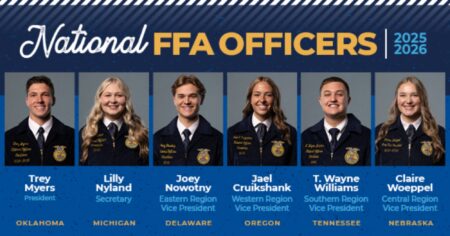By Ryan Hanrahan
United States farmer sentiment hit a 12-month low in August as producers expressed less optimism about the future and reported weak financial expectations for their farms in the coming year. It was the third month in a row that the barometer has declined.
“Sentiment differed widely among producers depending on whether their farm is primarily a crop operation or a livestock operation,” the Purdue/CME Group Ag Economy Barometer said. “Responses from crop producers this month were much less optimistic than those from livestock producers, which indicates the disparity in profitability between crop and livestock enterprises. Beef cattle operations in particular are experiencing record profitability as the smallest cattle inventory since 1951 has pushed cattle prices to record levels. This stands in sharp contrast to returns for crop production which have weakened in 2025.”
World Grain’s Arvin Donley reported that “farmers again reported weak financial expectations for their farms in the coming year. As in July, the Farm Financial Performance Index remained below 100. The reading of 91 barely changed from July’s index value.”
“Crop prices that stand below the cost of production for many farms help explain why more farmers expect weaker incomes for the coming year. The US Department of Agriculture (USDA) August Crop Production and World Agricultural Supply and Demand Estimates forecasted a 2025/2026 season average corn price of $3.90 per bushel and a soybean price of $10.10 per bushel,” Donley reported. “Both estimates fall well below estimated break-even levels for US farmers. Despite the weak income outlook, the Farm Capital Investment Index improved 8 points from July to 61. Livestock producers had a notably more optimistic outlook in August than crop producers, which helped push the index higher.”
More Producers Expect Larger Operating Loans
The Barometer said that “every January, the Ag Economy Barometer survey includes questions about farmers’ expectations regarding the size of their farm’s operating loan for the upcoming year and the reasons for the change in operating loan size.… Given concerns about weak farm income in 2025, the two questions about operating loans were added to the August barometer survey. Twenty-two percent of this month’s respondents said they expect their 2026 operating loan to be larger than in 2025. This was up somewhat from January, when 18% of respondents said they expected their 2025 loan size to increase compared to 2024.”
“In a follow-up question, farmers who said they expected their operating loan size to increase were asked for the reason behind the larger operating loan. Twenty-three percent of farmers in the August survey said it was because they expected to carry over unpaid operating debt from 2025 into 2026,” the Barometer said. “The combination of more farms expecting their loan size to increase, with 23% of those farms expecting to carry over operating debt, suggests that financial stress among farms increased from January to August. Perhaps more importantly, financial stress appears to be noticeably higher than it was in January 2023, when just 5% of farms with larger operating loans attributed that to the need to carry over unpaid operating debt, or January 2024 when 17% of farms with large operating loans said it was because of the same reason.”
“‘In sum, the August Ag Economy Barometer survey results show that U.S. farmers generally expect their financial performance for the coming year to drop from the previous year,’ said Michael Langemeier, the barometer’s principal investigator and director of Purdue University’s Center for Commercial Agriculture,” according to Donley’s reporting. “‘Despite a weakening Short-Term Farmland Value Expectations Index in August, more farmers still expect farmland values to rise rather than to weaken. Lastly, the percentage of farmers citing expectations for rising operating debt because of unpaid operating debt carrying over from the previous year could signal increasing farm financial stress in production agriculture.‘”
U.S. Farmer Sentiment Hits 12-Month Low in August was originally published by Farmdoc.


:max_bytes(150000):strip_icc()/Markets-1-Soybeans-field-dramatic-up-14-5283b95420d5449fbb4c6ffaa3fa212f.jpeg)
:max_bytes(150000):strip_icc()/10621203553_e4184253b6_o-676ad5aadaf34ba5ac4d51a79d251c1f.jpeg)



:max_bytes(150000):strip_icc()/101651819_farm_grain_bin_silo-e479c98f1adb4c99b25ae1603193debb.jpg)

:max_bytes(150000):strip_icc()/52513708671_2a6075fabe_o-dcd59efb1faf4c40afb3d8f39629aa7d.jpg)
:max_bytes(150000):strip_icc()/JaceYoung-ee4a04deb5fe4fbfa816744f027fcda5.jpg)
:max_bytes(150000):strip_icc()/pumpkins-_-cami-koons-2048x1545-b706ebeeace44615adaef29ad2c99f39.jpg)